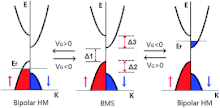Bipolar magnetic semiconductor
Bipolar magnetic semiconductors (BMSs) are a special class of magnetic semiconductors characterized by a unique electronic structure, where valence band maximum (VBM) and conduction band minimum (CBM) are fully spin polarized in the opposite spin direction.[1] BMSs can be described by three energy gaps, the spin-flip gap Δ2 in valence band (VB), band gap Δ1 and spin-flip gap Δ3 in conduction band (CB).[2] Up to now, bipolar magnetic semiconductors, together with half-metal and spin gapless semiconductor, have been viewed as three important classes of spintronic materials.[3][4]

Properties and potential applications
The proposal of bipolar magnetic semiconductor (BMS) is aimed to realize electrical control of carriers' spin orientation, which is a key scientific problem in developing high performance spintronics devices, since electric field can be easily applied locally, in contrast to magnetic field. In BMS, the carriers' spin orientation can be controlled simply by altering the sign of the applied gate voltage. Under zero gate voltage (VG = 0), BMS is semiconducting. Under negative gate voltages (VG < 0) which shift down the material's Fermi level (EF) into spin-flip gap Δ2 in valence band, BMS conducts with carriers fully spin up polarized, while the conducting carriers change to be fully spin down polarized when positive gate voltages (VG > 0) push the Fermi level (EF) up into spin-flip gap Δ3 in conduction band. BMS is expected to be applied as bipolar field effect spin filter and field effect spin valve, or entangled electron detectors and separators.[5][6]
Materials developments
A number of BMS materials have been theoretically predicted, such as MnPSe3 nanosheets, Heusler alloys FeVXSi (X = Ti, Zr), double perovskites A2CrOsO6 (A=Ca, Sr, Ba) and DPP-based metal–organic framework.[7][8][9][10] However, the experimental realization of electrical control of spin orientation in these materials still keeps a challenge and needs further experimental efforts.
References
- Farghadan, Rouhollah (2017-08-01). "Bipolar magnetic semiconductor in silicene nanoribbons". Journal of Magnetism and Magnetic Materials. ScienceDirect. 435: 206–211. doi:10.1016/j.jmmm.2017.04.016.
- Xingxing Li; Xiaojun Wu; Zhenyu Li; Jinlong Yang; Jianguo Hou (2012-07-20). "Bipolar magnetic semiconductors: a new class of spintronics materials". Nanoscale. 4 (18): 5680–5685. arXiv:1208.1355. Bibcode:2012Nanos...4.5680L. doi:10.1039/C2NR31743E. PMID 22874973.
- Hongzhe Pan; Yuanyuan Sun; Yongping Zheng; Nujiang Tang; Youwei Du (2016-09-09). "B4 CN3 and B3 CN4 monolayers as the promising candidates for metal-free spintronic materials". New Journal of Physics. 18 (9): 093021. Bibcode:2016NJPh...18i3021P. doi:10.1088/1367-2630/18/9/093021.
- Jiří Tuček; Piotr Błoński; Juri Ugolotti; Akshaya Kumar Swain; Toshiaki Enoki; Radek Zbořil (2018). "Emerging chemical strategies for imprinting magnetism in graphene and related 2D materials for spintronic and biomedical applications". Chemical Society Reviews. 47 (11): 3899–3990. doi:10.1039/C7CS00288B. PMID 29578212.
- Xingxing Li; Jinlong Yang (2013-08-07). "Bipolar magnetic materials for electrical manipulation of spin-polarization orientation". Physical Chemistry Chemical Physics. 15 (38): 15793–15801. Bibcode:2013PCCP...1515793L. doi:10.1039/C3CP52623B. PMID 23995379.
- Xingxing Li; Jinlong Yang (2016-04-19). "First-principles design of spintronics materials". National Science Review. 3 (3): 365–381. doi:10.1093/nsr/nww026.
- Xingxing Li; Xiaojun Wu; Jinlong Yang (2014-07-18). "Half-metallicity in MnPSe3 exfoliated nanosheet with carrier doping". Journal of the American Chemical Society. 136 (31): 11065–11069. doi:10.1021/ja505097m. PMID 25036853.
- Jiahui Zhang; Xingxing Li; Jinlong Yang (2015-01-27). "Electrical control of carriers' spin orientation in the FeVTiSi Heusler alloy". Journal of Materials Chemistry C. 3 (11): 2563–2567. arXiv:1411.3426. doi:10.1039/C4TC02587C.
- Xingxing Li; Xiaojun Wu; Zhenyu Li; Jinlong Yang (2015-09-18). "Proposal of a general scheme to obtain room-temperature spin polarization in asymmetric antiferromagnetic semiconductors". Physical Review B. 92 (12): 125202. Bibcode:2015PhRvB..92l5202L. doi:10.1103/PhysRevB.92.125202.
- Xingxing Li; Jinlong Yang (2019-04-29). "Toward Room-Temperature Magnetic Semiconductors in Two-Dimensional Ferrimagnetic Organometallic Lattices". The Journal of Physical Chemistry Letters. 10 (10): 2439–2444. doi:10.1021/acs.jpclett.9b00769. PMID 31034233.